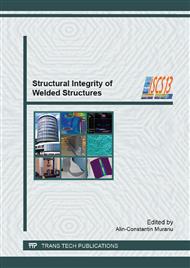[1]
S.Y. Chang, L.C. Tsao, Y.H. Lei, S.M. Mao, C.H. Huang: Brazing of 6061 aluminum alloy/Ti–6Al–4V using Al–Si–Cu–Ge filler metals, Journal of Materials Processing Technology, Volume 212, Issue 1, (2012) 8-14.
DOI: 10.1016/j.jmatprotec.2011.07.014
Google Scholar
[2]
D. Wei, X. Song-Bai, L. Ji-Yuan, L. Yin-Bin, W. Shui-Qing: Torch brazing 3003 aluminum alloy with Zn—Al filler metal, Transactions of Nonferrous Metals Society of China, Volume 22, Issue 1, (2012) 30-35.
DOI: 10.1016/s1003-6326(11)61135-7
Google Scholar
[3]
C. Dharmendra, K.P. Rao, J.Wilden, S. Reich: Study on laser welding–brazing of zinc coated steel to aluminum alloy with a zinc based filler, Materials Science and Engineering: A, Volume 528, Issue 3, (2011) 1497-1503.
DOI: 10.1016/j.msea.2010.10.050
Google Scholar
[4]
S.L. Richlen and W.P. Parks Jr.: Heat Exchangers, Engineered Materials Handbook, ASM International, 1991.
Google Scholar
[5]
W. Ming-Fang, e.o.: Contact reactive brazing of Al alloy/Cu/stainless steel joints and dissolution behaviors of interlayer, Transactions of Nonferrous Metal Society of China, (2011) 1035-1039.
DOI: 10.1016/s1003-6326(11)60818-2
Google Scholar
[6]
L. He-Zong, D. Xiang-Huai, S. Yu, Z. Rui, A. Diehl, H. Hagenah, U. Engel, M. Merklein, J. Cao: Analysis of microbending of CuZn37 brass foils based on strain gradient hardening models, Journal of Materials Processing Technology, Volume 212, Issue 3, (2012) pp.653-661.
DOI: 10.1016/j.jmatprotec.2011.10.007
Google Scholar
[7]
U. Hofmann, E. El-Magd, Behaviour of Cu-Zn alloys in high speed shear tests and in chip formation processes, Materials Science and Engineering: A, Volume 395, Issues 1–2, (2005) 129-140.
DOI: 10.1016/j.msea.2004.12.030
Google Scholar
[8]
I. Olaru, Study About Torch Brazing Technology, Buletinul Institutului Politehnic Iaşi, Universitatea Tehnică "Gh. Asachi" Iaşi, Tomul LIII (LVII), Fasc. 4, Ştiinţa şi Ingineria Materialelor, (2007) 195-200.
DOI: 10.37897/rjp.2015.1.14
Google Scholar
[9]
P.He, J.C. Feng, H.Zhou: Microstructure and strength of brazed joints of Ti3Al-base alloy with TiZrNiCu filler metal, Materials Science and Engineering, (2005) 81–86.
DOI: 10.1016/j.msea.2004.07.068
Google Scholar
[10]
D.L. Keller, e.o.: Wettability of Brazing Filler Metals, Welding Journal, vol. 69, no. 10, (1990) 31-34.
Google Scholar
[11]
I. Olaru, Researches regarding the use of aluminum alloys based brazing materials in order to obtain thin shells structures-Ph.D Thesis, Materials Science and Engineering, Universitatea Tehnică "Gh. Asachi" Iaşi, 2007.
Google Scholar
[12]
C. Leitão, B.Emílio, B.M. Chaparro, D.M. Rodrigues: Formability of similar and dissimilar friction stir welded AA 5182-H111 and AA 6016-T4 tailored blanks, Materials and Design, Volume 30, Issue 8, (2009) 3235-3242.
DOI: 10.1016/j.matdes.2008.12.005
Google Scholar
[13]
C.Leitão, R.M. Leal, D.M. Rodrigues, A.Loureiro, P.Vilac: Mechanical behavior of similar and dissimilar AA5182-H111 and AA6016-T4 thin friction stir welds, Materials and Design, Volume 30, (2009) 101–108.
DOI: 10.1016/j.matdes.2008.04.045
Google Scholar
[14]
*** ASM Handbook, Welding, Brazing and Soldering, Vol. 6, ASM International, 1999.
Google Scholar


